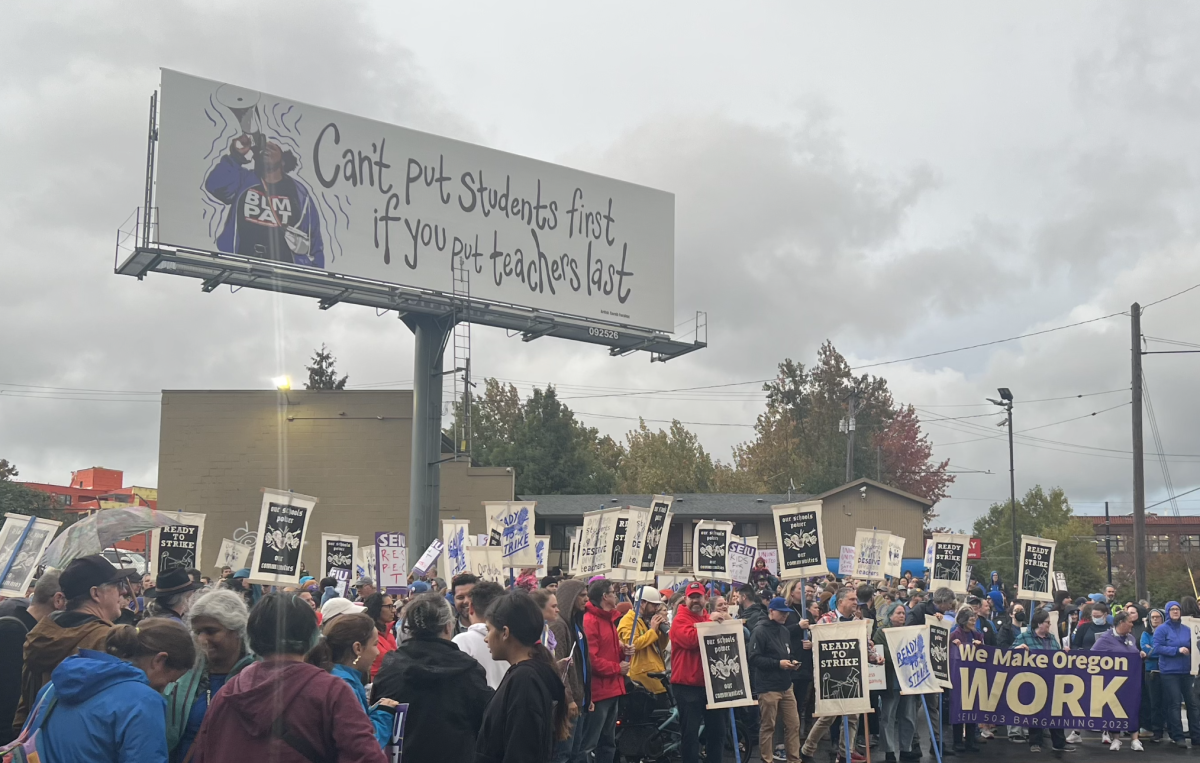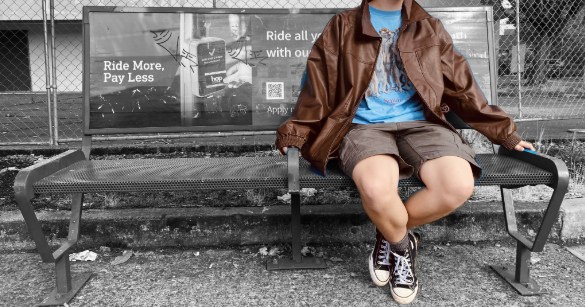
Disclaimer: As bargaining is a constantly evolving process, parts of this article may be outdated at the time of publication. All information is up to date as of Oct. 25, 2023 when we sent the article to press.
It’s a typical Thursday night for Portland Public Schools (PPS): some students cram into bleachers to watch their peers race across the turf, others are at their desks typing away on last-minute assignments. Yet at 10:07 p.m. every PPS community member in possession of a phone is united for a fleeting second. “PAT Notice to Strike on Nov 1” is the bold headline of the Oct. 19 Trivory post made by Jonathan Garcia, PPS’ chief of staff. Earlier that same night, the Portland Association of Teachers (PAT) provided PPS with a notice of their intention to strike. Unless the district and the union can come to an agreement before Nov. 1, schools will indefinitely close.
According to Angela Bonilla, the president of the PAT, the PAT’s demands “boil down to safety, respect, and student-centered supports.” Additional planning time, hard class size caps, and pay raises are among the changes the union is requesting. PPS officials question where the funding for the PAT’s proposal will come from, leading into one of the largest points of contention: the cost-of-living-adjustment. There is a $228.4 million disparity between both parties’ offers, with the PAT requesting a 23% cumulative increase in pay over three years and PPS counter-offering a 10.9% cumulative increase. In educators’ current contract, salaries range from $50,020 to $97,333 at a reported average of $87,000 a year. In the most recent contract proposed by PPS, educators would make a minimum of around $61,700 with 60% making over $90,000 during the 2025 to 2026 salary schedule.
As the path to home ownership becomes increasingly arduous for Portlanders, Bonilla highlights the frustrations of the PAT members: “How are we supposed to stay invested in our school communities if we can’t even live in these communities?” She suggests putting less money into the PPS reserve fund, stating, “They say it’s being held for a rainy day but… our kids are already soaking wet.”
However, the district is wary of expending reserves as student enrollment numbers are dropping and politicians struggle to agree on how much funding to provide public education. The district reports that inflation has increased twice as much as their revenue, which comes primarily from the state. Board policy dictates that PPS is to keep a minimum reserve balance of 5% of the annual general fund balance, yet sets the “expectation that the district will achieve and sustain a 10% reserve.” Currently, the reserves are at around $105 million, representing roughly 10% of the district’s operating budget, according to the PPS communications team. Additionally, close to $55 million of this has been budgeted for operations during 2023 to 2024, meaning the district will end the year with around $60 million or about 6% of the budget in the reserve balance. Reserve funds are used in emergency scenarios; if the state legislature was unable to agree on the educational budget allotment, the funds would need to be implemented.
There are also significant differences over proposals of teacher planning time. The PAT has presented schedules that ensure a minimum of 440 minutes of weekly planning time for educators K-12. The district’s proposal suggests a 400 minute minimum for K-5, while middle and high school educators would continue with one period per day. For elementary school educators this is a significant increase from the previous contract’s 320 minute requirement, but PPS is hesitant to further modify instructional time as the PAT’s proposal would decrease the school year by one day. Yet based on the PAT’s Oct. 17 supposal, their suggested schedule allows students to “receive 37 more hours of instruction throughout the year from educators who have had more time to plan and [had] more professional development.” This is based on an eight hour day in exchange for the removal of weekly staff meetings.
Another source of disagreement is student discipline. PPS seeks to end mandatory five-day suspensions for instances of student violence against educators, citing disproportionate impacts on Black students. Their proposal suggests looking at each incident of threatened or actual harm on a case-by-case basis. The PAT originally opposed this unless the five days were replaced with support for the student, but in their most recent proposal accepted the edit. They replaced the requirement for immediate suspension with “The student shall be removed from school until an effective Tier III intervention has been identified and fully implemented.” The PAT have also added language requesting spaces for activated students to decompress, asking for de-escalation rooms at each school. PPS believes these rooms would be exclusionary.
The previous contract expired in June of 2023, and negotiations for a new three-year contract began in Oct. 2022, transitioning into state-led mediation at the end of Aug. 2023. In addition to previously mentioned demands, disagreements have continued over the PAT’s requests for lower case loads, additional special education supports, and a land inventory to identify potential housing developments for low-income students, with the PAT declaring an impasse on Sept. 15. An impasse signifies that a party believes no further progress can be made in negotiations. Oregon state law requires both parties to submit a written best offer within seven days of the impasse, followed by a 30-day cooling off period. Each group’s final best offers were presented Sept. 22.
Following the cooling off period, the PAT held a vote of their over 3,700 members on whether the union should strike, and from Oct. 16 to Oct. 19, 2023, 93% of members cast ballots, with 98.9% of them voting in favor of authorizing a strike. Shortly after, the PAT sent a state-mandated 10-day notice to the district informing them of the strike. In these last few days of mediation, the district and the union will have their final opportunities to come to an agreement. If they can’t, schools will have no choice but to close.
School closures have many community members worrying over potential educational setbacks. Bonilla acknowledges this, stating, “We’re worried about the disrupted learning from a strike,” but remarks that “we’ve been worried about disrupted learning since COVID.” Additionally, a temporary hold would be placed on junior varsity (JV) athletics and school-based extracurriculars such as performing arts. In the days following the notice to strike, rumors filled schools that students would lose access to Canvas, Synergy, and their Google accounts, but the district has confirmed these rumors to be untrue.
It’s important to note that educators may continue working, and the district is still developing the expectations for those who choose not to strike. If a teacher chooses to strike they cannot participate in any instruction, so with the critical mass of educators planning to strike, instruction will not be possible. However, students will have access to supplemental online learning activities through PPS’ Student Instructional Resources. In addition, limited virtual college application support will be available. Nevertheless, teachers and counselors cannot write letters of recommendation while on strike. Some Oregon colleges are offering a two-week extension on letter of recommendation submissions, but for the most part a “Statement of Work Stoppage” will automatically be attached to college applications submitted on MaiaLearning.
Impacts of a strike are felt beyond the classroom; for staff, Bonilla says, “We don’t take striking lightly because our members are literally on the edge of being able to afford housing, clothing, food … If we go on strike, we’re getting a pay cut while we’re on strike.” According to an Oct. 24 email sent by the district to teachers, if a union member strikes for more than half of the contract days in November “it will impact [their] group health benefits for December.” For families, they’re faced with finding last-minute childcare and other resources that their schools typically provide, although grab-and-go meals will continue to be offered. Pickup locations are still being finalized. Both the union and PPS see striking as a last resort, however as major budgeting discrepancies persist, so does the potential for a strike.
A coalition of three unions represented under PPS are all hitting the bargaining tables with the district. Along with the PAT, the Portland Federation of School Professionals (PFSP) and the Service Employees International Union (SEIU) are also in bargaining. PAT members are the highest paid under the coalition. Although their legal processes aren’t 100% in sync, the coalition’s general messages are: you can’t prioritize students while neglecting staff. Students have become the “face” of the coalition’s demands as the unions have framed their offers around the kids, in hopes of building strong public backing. The district leverages a similar strategy, referencing the negative impact of school closures on students. Some students have formed strike solidarity committees, showing up to the PAT-led demonstrations, while others express frustration over the potential disruption to their learning.
As the teacher strike looms over Portland, pressure on the district rises from the three unions renegotiating their contracts. The pressure climaxed at a practice picket and rally on Oct. 10 when representatives and members from each union banded together outside of the PPS headquarters, pleading with the district to meet their demands. “Hey dad, what do we want?” begins an elementary schooler clad in a neon yellow raincoat. “A contract,” is the fiery response from Kenny Bennett, a teacher at Astor K-8.
Among the crowd is the SEIU Local 140, which represents PPS’ custodial staff and nutrition services. Representatives held signs reading “25 to survive” referencing demands for wages that meet their cost of living in Portland. They’ve been negotiating their contracts with PPS since February, and Jim Darcy, a custodian at Llewellyn Elementary School and union co-chair for the SEIU says, “We initially gave them proposals in April, they didn’t respond until June, and when they did they rejected almost everything.” SEIU’s demands include higher wages, better staffing, hazard pay, and safer working conditions.
The bargaining period between the SEIU and PPS is set to end Nov. 9, 2023, and despite over seven months of bargaining, the two have reached only a few agreements and are still far off from a deal. The union could end up following a similar path to the PAT, potentially reaching a strike.
The Portland Federation of School Professionals (PFSP) which represents 1,350 paraeducators, campus security agents, school administrative assistants, and other staff under PPS has been bargaining with the district. The two reached a full tentative agreement in mid-September, but soon after, the agreement was shot down in a vote by PFSP members. In a Facebook post addressing the vote, PFSP President John MacDuffee said, “Our members are frustrated and exhausted. They want a living wage, safe working conditions, and a higher quality of life.” The PFSP and the district will return to bargaining tables in the coming months.
PPS describes their bargaining goal as “a fair, sustainable settlement that honors our educators, focuses on student learning, and avoids school closures,” upholding the position that there simply isn’t enough money to meet the PAT’s demands. Bonilla expresses the hope that “we are going to have a relationship with the district that is more equal, where they see us, as they should, as equal partners.”
Families frantically refresh for updates, teachers prepare for pay loss and classroom closures, and the district bargains with the coalition of unions while developing contingency plans for the unclear future. The entire community is watching closely in the final moments of what could be a first for the district.
PPS provides further information about bargaining and school closures at pps.net/bargaining. For more specific details about programming during the closures see pps.net/Page/21472. A link to the district’s LetsTalk is located at the bottom of both these pages and community members are encouraged to submit questions through the site. The PAT also issues bargaining updates which can be found at pdxteachers.org.




































